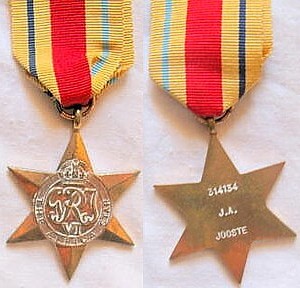
The Africa Star is a military campaign medal, instituted by the United Kingdom on 8 July 1943 for award to British and Commonwealth forces who served in North Africa between 10 June 1940 and 12 May 1943 during the Second World War.
Abyssinian campaign can mean:

The British Expedition to Abyssinia was a rescue mission and punitive expedition carried out in 1868 by the armed forces of the British Empire against the Ethiopian Empire. Emperor Tewodros II of Ethiopia, then often referred to by the anglicized name Theodore, imprisoned several missionaries and two representatives of the British government in an attempt to force the British government to comply with his requests for military assistance. The punitive expedition launched by the British in response required the transportation of a sizeable military force hundreds of kilometres across mountainous terrain lacking any road system. The formidable obstacles to the action were overcome by the commander of the expedition, General Robert Napier, who captured the Ethiopian capital, and rescued all the hostages.
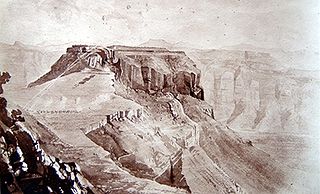
The Battle of Magdala was the conclusion of the British Expedition to Abyssinia fought in April 1868 between British and Abyssinian forces at Magdala, 390 miles (630 km) from the Red Sea coast. The British were led by Robert Napier, while the Abyssinians were led by Emperor Tewodros II.

The India General Service Medal was a campaign medal approved on 1 March 1854, for issue to officers and men of the British and Indian armies. It was awarded for various minor military campaigns in India and nearby countries, between 1852 and 1895.

The Indian General Service Medal was a campaign medal approved on 1 January 1909, for issue to officers and men of the British and Indian armies. From 1919, it was also awarded to officers and men of the Royal Air Force, with the Waziristan 1925 clasp awarded solely to the RAF.

The Indian General Service Medal was a campaign medal approved on 3 August 1938, for issue to officers and men of the British and Indian armies, and of the Royal Air Force.
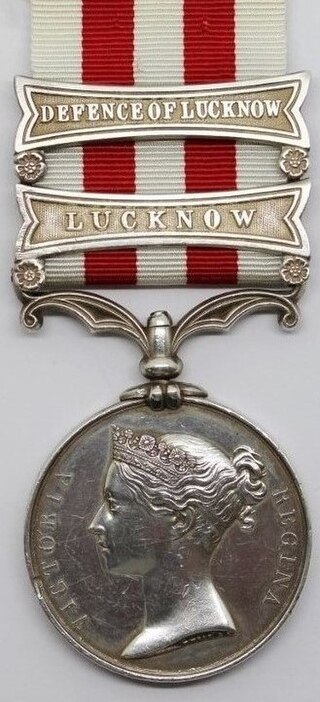
The Indian Mutiny Medal was a campaign medal approved in August 1858, for officers and men of British and Indian units who served in operations in suppression of the Indian Rebellion of 1857.

The South Africa Medal (1853) is a campaign medal instituted in 1854, for award to officers and men of the Royal Navy, British Army and locally recruited Cape Mounted Riflemen, who served in the Cape of Good Hope during the Xhosa Wars between 1834 and 1853.

The Army of India Medal (AIM) was a campaign medal approved in 1851 for issue to officers and men of the British Army and the Army of the Honourable East India Company. A retrospective award following the precedent set by the Naval General Service Medal and the Military General Service Medal, it served to reward service in various actions from 1803 to 1826.
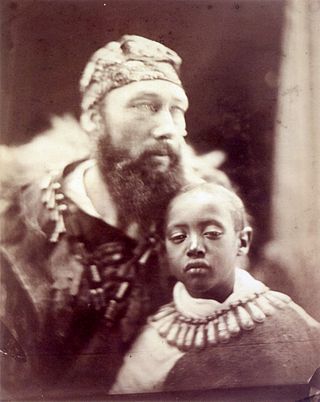
Tristram Charles Sawyer Speedy was a well-known English explorer and adventurer during the Victorian era.

The China War Medal 1900 was a British campaign medal approved on 1 January 1902 for issue to British and Indian land and sea troops who served during the Boxer Rebellion, between 10 June and 31 December 1900. The medal was issued in silver to combatants and in bronze to native, namely Indian, bearers drivers and servants.
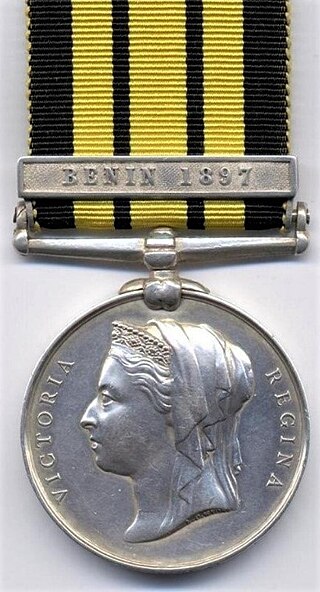
The East and West Africa Medal, established in 1892, was a campaign medal awarded for minor campaigns that took place in East and West Africa between 1887 and 1900. A total of twenty one clasps were issued.
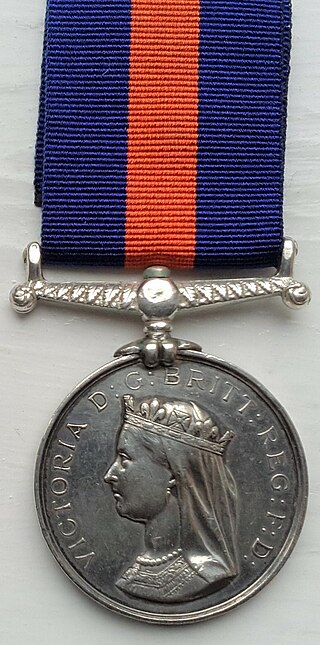
The New Zealand War Medal was a campaign medal authorised in 1869 to be awarded to Imperial and Colonial troops involved in the New Zealand Wars of 1845–47 and 1860–66. The New Zealand Wars were previously known as the Māori Wars, Anglo-Māori Wars or Land Wars.
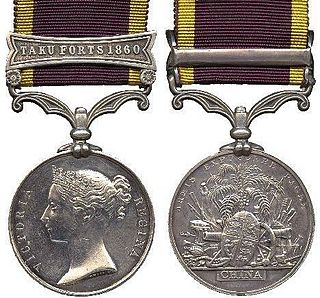
The Second China War Medal was issued by the British Government in 1861 to members of the British and Indian armies and Royal Navy who took part in the Second Opium War of 1857 to 1860 against China. The medal was designed by William Wyon.

The Seringapatam Medal, or Sri Ranga Pattanam Medal, is a campaign medal that was awarded by the Governor-General of India to all British and Indian soldiers who participated in the British victory in the Battle of Seringapatam in 1799.

The Jellalabad Medal was a campaign medal issued by the British East India Company. It was established by Lord Ellenborough, the Governor-General of India, on 30 April 1842.
The medal was awarded for the defence of Jalalabad from 12 November 1841 to 7 April 1842, during the First Afghan War, to the troops under the command of Sir Robert Sale. About 2,600 soldiers took part, including the 13th Foot, the 35th Bengal Native Infantry, as well as detachments from other Indian Army units and some loyal Afghan forces.

The Central Africa Medal was a British campaign medal awarded for service from 1891 to 1894 in Eastern and Central Africa, and from 1894 to 1898 for service in British Central Africa.

The Java Medal is a campaign medal awarded by the Governor-General of India to soldiers of the armies of the Honourable East India Company (HEIC) who participated in the Invasion of Java in August and September 1811, during the Napoleonic Wars.

The Deccan Medal was the first campaign medal instituted by the East India Company (EIC). It was awarded to native Indian troops who took part in the major campaigns in India between 1778 and 1784. It is sometimes referred to as the Carnatic Medal.



















